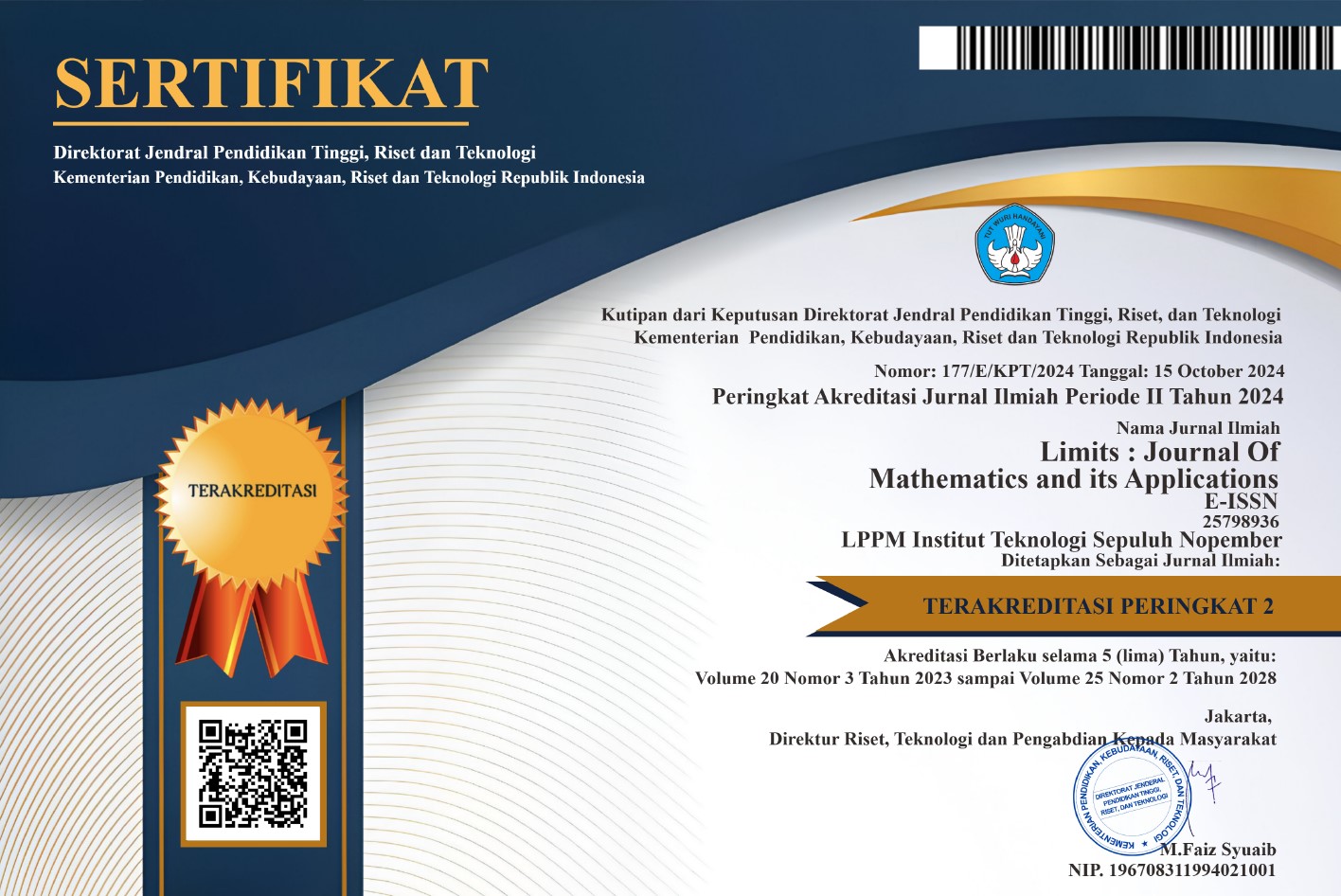Model Regresi Gamma untuk Menganalisis Indeks Pengeluaran Kabupaten/Kota di Pulau Sumatra
DOI:
https://doi.org/10.12962/limits.v22i1.3375Keywords:
Gamma regression, MSE, IDPM, Expenditure IndexAbstract
Gamma regression is part of Generalised Linear Models (GLMs) that can model data that is positive and asymmetric. The occurrence of data asymmetry is common in everyday life, for example in Human Development Index (HDI) data. The HDI has indicators called the Human Development Dimension Index, including the expenditure index, the education index and the life expectancy index. This study aims to model the expenditure index of districts/cities in Sumatra using Gamma regression because the expenditure index data is positive and non-symmetric. In modelling the Expenditure Index, the predictor variables used are the percentage of poor population, population density, percentage of population using their own toilet, and open unemployment rate in each district/city in Sumatra in 2023. The data used were obtained from the BPS website of the province corresponding to the regency/city in Sumatra. Based on the results of the analysis, all the predictor variables used had a significant effect on the expenditure index at the 1% and 5% significance levels, and the standard error value of each parameter estimate was small. In addition, the MSE of the model is also classified as small, which is 0.00163. This can prove that the model is supported by the data, although the coefficient of determination of the model ( ) in this study is only 47.59%.
Downloads
References
Badan Pusat Statistik Sumatera Barat, “Indeks Pembangunan Manusia Sumatera Barat Tahun 2023.” Accessed: Nov. 25, 2024. [Online]. Available: https://sumbar.bps.go.id
Badan Pusat Statistik, “Tanya Jawab Seputar Indeks Pembangunan Manusia (IPM).” Accessed: Nov. 25, 2024. [Online]. Available: https://pamekasankab.bps.go.id
K. I. Subramanian SV, “Income inequality and health: what have we learned so far?,” Epidemiologi Review, vol. 26, no. 1, pp. 78–91, 2004.
Badan Pusat Statistik (BPS) Sumatera Selatan, “Indeks Pembangunan Manusia Sumatera Selatan Tahun 2023. BPS Sumsel,” 2023. Accessed: Nov. 25, 2024. [Online]. Available: https://sumsel.bps.go.id
B. Jørgensen, “Exponential Dispersion Models,” Journal of the Royal Statistical Society, vol. 49, no. 2, pp. 127–162, 1987.
M. Corrales and E. Cepeda-Cuervo, “A Bayesian Approach to Mixed Gamma Regression Models,” Rev Colomb Estad, vol. 42, pp. 81–99, Mar. 2019, doi: 10.15446/rce.v42n1.69334.
D. Retnowati and Z. Zumaeroh, “Faktor-Faktor Yang Mempengaruhi Indeks Pembangunan Manusia di Indonesia,” Jurnal Nusantara, vol. 11, no. 3, pp. 45–57, 2023.
P. McCullagh and J. A. Nelder, Generalized Linear Models (2nd edition). New York: Chapman & Hall, 1989. doi: https://doi.org/10.1201/9780203753736.
M. L. Corrales and E. C. Cuervo, “A Bayesian Approach to Mixed Gamma Regression Models,” Colombian Journal of Statistics/Revista Colombiana de Estadística, vol. 42, no. 1, 2019.
M. Schmid and T. Hothorn, “Flexible Boosting of Accelerated Failure Time Models,” BMC Bioinformatics, vol. 9, no. 1, p. 269, 2008, doi: https://doi.org/10.1186/1471-2105-9-269.
A. J. Dobson and A. G. Barnett, An Introduction to Generalized Linear Models Fourth Edition, 4th ed. 2018. doi: https://doi.org/10.1201/9781315182780.
W. H. Greene, Econometric Analysis (7th ed.). Boston: Pearson Education, 2012.
A. Widodo, W. Waridin, and J. M. Kodoatie, “Analisis Pengaruh Pengeluaran Pemerintah di Sektor Pendidikan dan Kesehatan terhadap Pengentasan Kemiskinan Melalui Peningkatan Pembangunan Manusia di Provinsi Jawa Tengah,” Jurnal Dinamika ekonomi pembangunan, vol. 1, no. 1, pp. 25–42, 2011.
T. Tambunan, “Economic Growth, Appropriate Policies and Poverty Reduction in a Developing Country: Some Experience from Indonesia,” South Asia Economic Journal, vol. 6, no. 1, pp. 59–78, 2005, doi: 10.1177/139156140500600104.
P. Hall, The Jackknife, the Bootstrap and Other Resampling Plans. New York, NY: Springer New York, 2008. doi: 10.1007/978-0-387-75692-9_11.
B. Bhattacharya, “Tests of Parameters of Several Gamma Distributions with Inequality Restrictions,” Ann Inst Stat Math, vol. 54, pp. 565–576, 2002, doi: https://doi.org/10.1023/A:1022411127154.
M. Lavine, Introduction to Statistical Thought. JASA, 2009.
P. McCullagh, “Quasi-Likelihood Functions,” the annals of statistics, vol. 11, no. 1, pp. 59–67, 1983, doi: DOI: 10.1214/aos/1176346056.
D. Roxbee, Theoritical Statistics, 1 st Edition. New York: Chapman and Hall, 1974. doi: https://doi.org/10.1201/b14832.
H. Yasin, S. Inayati, and S. Setiawan, “3-PARAMETER GAMMA REGRESSION MODEL FOR ANALYZING HUMAN DEVELOPMENT INDEX OF CENTRAL JAVA PROVINCE,” BAREKENG: Jurnal Ilmu Matematika dan Terapan, vol. 16, no. 1, pp. 171–180, Mar. 2022, doi: 10.30598/barekengvol16iss1pp171-180.
D. E. Putri, Purhadi, and D. D. Prastyo, “Parameter estimation and hypothesis testing on geographically weighted gamma regression,” in Journal of Physics: Conference Series, Institute of Physics Publishing, Oct. 2017. doi: 10.1088/1742-6596/893/1/012025.
M. F. Zarate, R. Duplat, C. Elias, P. Maintainer, and M. Corrales, “Package ‘Gammareg’ Type Package Title Classic Gamma Regression: Joint Modeling of Mean and Shape Parameters License GPL (>= 2),” 2023. [Online]. Available: http://www.docentes.unal.edu.co/ecepedac/docs/MODELAGEM20DA20VARIABILIDADE.pdf.





